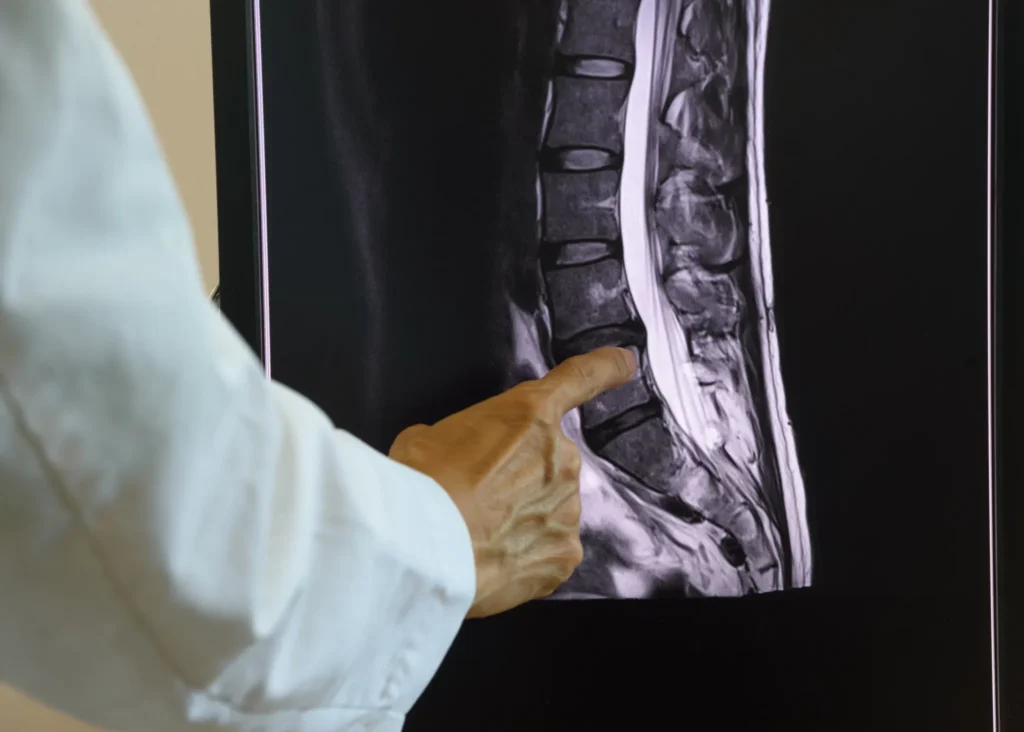he spine is a complex structure made up of bones, muscles, ligaments, nerves, and discs. It supports the body’s weight, allows flexible movement, and protects the spinal cord—a critical part of the nervous system

The upper portion, consisting of seven vertebrae.

Twelve vertebrae in the middle part of the back, attached to the ribs.

Five vertebrae that bear much of the body's weight, making this region prone to injury.

Spine injuries can range from minor strains to severe damage affecting the spinal cord. Knowing these common types is important for timely diagnosis and treatment.

A herniated disc happens when the soft center of a spinal disc pushes through its outer layer, pressing on nerves and causing pain, numbness, or weakness.

Vertebral fractures often result from trauma like accidents or falls and can cause nerve damage or paralysis depending on severity and location.

Damage to the spinal cord can lead to loss of sensation or movement below the injury site, sometimes resulting in partial or full paralysis.

Sprains are tears in ligaments, while strains affect muscles or tendons. Both can result from sudden movements, lifting, or overuse and cause pain and stiffness.
Spine injuries can result from various incidents, many involving negligence or unsafe environments. Here are some of the most common causes

Car crashes are a leading cause of spinal injuries. Sudden impact can damage the spinal cord or vertebrae. A spine injury lawyer can help victims pursue compensation.

High-impact sports like football, gymnastics, or diving can cause spinal trauma and. If safety measures were lacking, legal action may be possible.

Slips on wet main road full or uneven surfaces can lead to serious back or spinal injuries. Property owners may be held liable for unsafe conditions.

Surgical errors, improper anesthesia, or misdiagnosis can lead to spinal damage and negligence . Victims may have a claim for medical negligence.

Jobs involving heavy lifting, falls, or unsafe equipment often cause spinal injuries. Victims may be entitled to workers’ compensation or additional legal claims.

Acts of violence—such as physical attacks or gunshot wounds—can cause severe spinal injuries. Civil lawsuits can help victims recover damages.
Spine injuries can cause lasting challenges that impact mobility and daily life. Proper management is essential for recovery.
Recovering strength and movement often requires ongoing rehabilitation, including tailored exercise routines and hands-on therapy.

Certain injuries may require surgery to correct spinal damage or relieve pressure on nerves, with recovery times varying by procedure.

Long-term pain is a frequent issue following spine injuries and may require a combination and lifestyle changes to manage effectively.

Knowing the available compensation types helps ensure you receive fair and comprehensive support after a spine injury.

Covers past, present, and future medical bills related to treatment, rehabilitation, and medications.

Compensation for lost wages during recovery and potential future and earnings lost due to disability.

Non-economic damages for the physical pain and emotional distress caused by the injury, including impact on quality of life.
Several legal factors can influence the outcome of your spine injury claim and potential compensation.

Every state has specific time limits, known as statutes of limitations, for filing injury claims. Missing these deadlines can bar your case.

If you are partly at fault for the injury, your compensation may be reduced according to comparative negligence laws.

Pre-existing spine conditions or injuries can affect your claim’s strength and value. Accurate medical records are critical.
The time limit varies by state but is usually between one to three years from the date of the injury. It’s important to file as soon as possible to avoid missing deadlines.
Compensation may include medical expenses, lost wages, pain and suffering, disability benefits, and other related costs depending on the specifics of your case.
Knapp Moss works exclusively on a contingency fee basis, meaning you pay nothing upfront and the firm takes a percentage of any settlement or award. We don’t make any money until we win your case and get you paid.
Case duration varies depending on complexity, insurance negotiations, and court schedules. Some cases settle within months, while others may take years.
By clicking Sign Up, you are confirming that you agree with our Terms and Conditions.